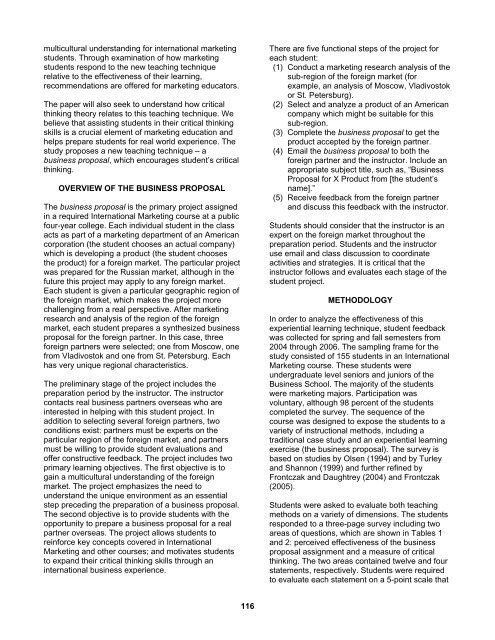2008 - Marketing Educators' Association
2008 - Marketing Educators' Association
2008 - Marketing Educators' Association
Create successful ePaper yourself
Turn your PDF publications into a flip-book with our unique Google optimized e-Paper software.
multicultural understanding for international marketing<br />
students. Through examination of how marketing<br />
students respond to the new teaching technique<br />
relative to the effectiveness of their learning,<br />
recommendations are offered for marketing educators.<br />
The paper will also seek to understand how critical<br />
thinking theory relates to this teaching technique. We<br />
believe that assisting students in their critical thinking<br />
skills is a crucial element of marketing education and<br />
helps prepare students for real world experience. The<br />
study proposes a new teaching technique – a<br />
business proposal, which encourages student’s critical<br />
thinking.<br />
OVERVIEW OF THE BUSINESS PROPOSAL<br />
The business proposal is the primary project assigned<br />
in a required International <strong>Marketing</strong> course at a public<br />
four-year college. Each individual student in the class<br />
acts as part of a marketing department of an American<br />
corporation (the student chooses an actual company)<br />
which is developing a product (the student chooses<br />
the product) for a foreign market. The particular project<br />
was prepared for the Russian market, although in the<br />
future this project may apply to any foreign market.<br />
Each student is given a particular geographic region of<br />
the foreign market, which makes the project more<br />
challenging from a real perspective. After marketing<br />
research and analysis of the region of the foreign<br />
market, each student prepares a synthesized business<br />
proposal for the foreign partner. In this case, three<br />
foreign partners were selected; one from Moscow, one<br />
from Vladivostok and one from St. Petersburg. Each<br />
has very unique regional characteristics.<br />
The preliminary stage of the project includes the<br />
preparation period by the instructor. The instructor<br />
contacts real business partners overseas who are<br />
interested in helping with this student project. In<br />
addition to selecting several foreign partners, two<br />
conditions exist: partners must be experts on the<br />
particular region of the foreign market, and partners<br />
must be willing to provide student evaluations and<br />
offer constructive feedback. The project includes two<br />
primary learning objectives. The first objective is to<br />
gain a multicultural understanding of the foreign<br />
market. The project emphasizes the need to<br />
understand the unique environment as an essential<br />
step preceding the preparation of a business proposal.<br />
The second objective is to provide students with the<br />
opportunity to prepare a business proposal for a real<br />
partner overseas. The project allows students to<br />
reinforce key concepts covered in International<br />
<strong>Marketing</strong> and other courses; and motivates students<br />
to expand their critical thinking skills through an<br />
international business experience.<br />
116<br />
There are five functional steps of the project for<br />
each student:<br />
(1) Conduct a marketing research analysis of the<br />
sub-region of the foreign market (for<br />
example, an analysis of Moscow, Vladivostok<br />
or St. Petersburg).<br />
(2) Select and analyze a product of an American<br />
company which might be suitable for this<br />
sub-region.<br />
(3) Complete the business proposal to get the<br />
product accepted by the foreign partner.<br />
(4) Email the business proposal to both the<br />
foreign partner and the instructor. Include an<br />
appropriate subject title, such as, “Business<br />
Proposal for X Product from [the student’s<br />
name].”<br />
(5) Receive feedback from the foreign partner<br />
and discuss this feedback with the instructor.<br />
Students should consider that the instructor is an<br />
expert on the foreign market throughout the<br />
preparation period. Students and the instructor<br />
use email and class discussion to coordinate<br />
activities and strategies. It is critical that the<br />
instructor follows and evaluates each stage of the<br />
student project.<br />
METHODOLOGY<br />
In order to analyze the effectiveness of this<br />
experiential learning technique, student feedback<br />
was collected for spring and fall semesters from<br />
2004 through 2006. The sampling frame for the<br />
study consisted of 155 students in an International<br />
<strong>Marketing</strong> course. These students were<br />
undergraduate level seniors and juniors of the<br />
Business School. The majority of the students<br />
were marketing majors. Participation was<br />
voluntary, although 98 percent of the students<br />
completed the survey. The sequence of the<br />
course was designed to expose the students to a<br />
variety of instructional methods, including a<br />
traditional case study and an experiential learning<br />
exercise (the business proposal). The survey is<br />
based on studies by Olsen (1994) and by Turley<br />
and Shannon (1999) and further refined by<br />
Frontczak and Daughtrey (2004) and Frontczak<br />
(2005).<br />
Students were asked to evaluate both teaching<br />
methods on a variety of dimensions. The students<br />
responded to a three-page survey including two<br />
areas of questions, which are shown in Tables 1<br />
and 2: perceived effectiveness of the business<br />
proposal assignment and a measure of critical<br />
thinking. The two areas contained twelve and four<br />
statements, respectively. Students were required<br />
to evaluate each statement on a 5-point scale that


